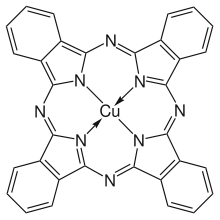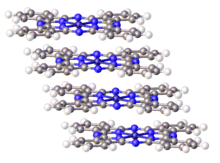Phthalocyanine Blue BN
Phthalocyanine Blue BN, also called by many names (EINECS 205-685-1), is a bright, crystalline, synthetic blue pigment from the group of phthalocyanine dyes. Its brilliant blue is frequently used in paints and dyes. It is highly valued for its superior properties such as light fastness, tinting strength, covering power and resistance to the effects of alkalis and acids. It has the appearance of a blue powder, insoluble in most solvents including water.
 | |
| Names | |
|---|---|
| IUPAC name
(29H,31H-phthalocyaninato(2−)-N29,N30,N31,N32)copper(II) | |
| Other names
Monastral blue, phthalo blue, thalo blue | |
| Identifiers | |
3D model (JSmol) |
|
| ChEBI | |
| ECHA InfoCard | 100.005.169 |
| UNII | |
CompTox Dashboard (EPA) |
|
| |
| Properties | |
| C32H16CuN8 | |
| Molar mass | 576.082 g·mol−1 |
| Appearance | dark blue solid |
Except where otherwise noted, data are given for materials in their standard state (at 25 °C [77 °F], 100 kPa). | |
| Infobox references | |
| Phthalo Blue | |
|---|---|
Phthalocyanine blue pigment powder | |
| Hex triplet | #000F89 |
| sRGBB (r, g, b) | (0, 15, 137) |
| CMYKH (c, m, y, k) | (100, 98, 16, 14) |
| HSV (h, s, v) | (233°, 100%, 54%) |
| Source | The Mother of All HTML Colo(u)r Charts |
| ISCC–NBS descriptor | Vivid blue |
| B: Normalized to [0–255] (byte) H: Normalized to [0–100] (hundred) | |
History
CuPc was first prepared in 1927 by the reaction of copper(I) cyanide and o-dibromobenzene, with the apparent intent of preparing phthalonitrile. A couple of years later, workers at Scottish obtained CuPc, FePc, and NiPc from reactions of phthalic anhydride and ammonia. Specifically at the ICI phthalimide plant, a blue contaminant was traced to a byproduct formed when the phthalimide reacted with trace amounts of iron from the metal reactor. The chemist took samples of this blue and using sulfuric acid as a solvent, managed to produce a workable pigment. These leads led to the blue pigment sold under the trade name Monastral. Industrial production commenced in 1935 at ICI, I.G. Farbenindustrie, and DuPont.[1]
Difficulty was experienced in forming stable dispersions with the first alpha forms, especially in mixtures with rutile titanium, where the blue pigment tended to flocculate. The beta form was more stable, as was the improved stabilized alpha form. Today, there are even more isomeric forms available.
Synonyms and trade names
The substance, chemical name (29H,31H-phthalocyaninato(2−)-N29,N30,N31,N32)copper(II) (or copper phthalocyanine),[2] is also known as monastral blue, phthalo blue, helio blue, thalo blue, Winsor blue, phthalocyanine blue, C.I. Pigment Blue 15:2, copper phthalocyanine blue, copper tetrabenzoporphyrazine, Cu-phthaloblue, PB-15, PB-36, C.I. 74160, and British Rail Blue. Numerous other trade names and synonyms exist.[3] The abbreviation "CuPc" is also used.[4]
Applications
Catalysis
Metal phthalocyanines have long been examined as catalysts for redox reactions. Areas of interest are the oxygen reduction reaction and the sweetening of gas streams by removal of hydrogen sulfide.
Colorant
Due to its stability, phthalo blue is also used in inks, coatings, and many plastics. The pigment is insoluble and has no tendency to migrate in the material. It is a standard pigment used in printing ink and the packaging industry. Industrial production was of the order of 10,000 tonnes per annum in the 1980s and 1990s in Japan alone.[3] The pigment is the highest volume pigment produced.[5]
All major artists' pigment manufacturers produce variants of copper phthalocyanine, designated color index PB15 (blue) and color indexes PG7 and PG36 (green).
A common component on the artist's palette, phthalo blue is a cool blue with a bias towards green. It has intense tinting strength and easily overpowers the mix when combined with other colors. It is a transparent staining color and can be applied using glazing techniques.
This colour is also present in Lidl's Dentalux Total Care Plus toothpaste, listed as the final ingredient.
Research
Although never commercialized, CuPc has often been investigated in the context of molecular electronics. It is well suited for organic solar cells because of its high chemical stability and uniform growth.[6][7][8] CuPc usually plays the role of the electron donor in donor/acceptor based solar cells. One of the most common donor/acceptor architectures is CuPc/C60 (buckminsterfullerene) which rapidly became a model system for the study of small organic molecules.[9][10] Photon to electron conversion efficiency in such system reaches approximately 5%.
CuPc has been investigated as a component of organic field-effect transistors.[11] Copper Phthalocyanine (CuPc) has been suggested for data storage in quantum computing, due to the length of time its electrons can remain in superposition.[12]
The compound has also been investigated in the context of quantum computing.[13] CuPc can be easily processed into a thin film for use in device fabrication, which makes it an attractive qubit candidate.[14]
CuPc derivatives
Approximately 25% of all artificial organic pigments are phthalocyanine derivatives.[15] Copper phthalocyanine (CuPc) dyes are produced by introducing solubilizing groups, such as one or more sulfonic acid functions. These dyes find extensive use in various areas of textile dyeing (Direct dyes for cotton), for spin dyeing and in the paper industry. Direct blue 86 is the sodium salt of CuPc-sulfonic acid, whereas direct blue 199 is the quaternary ammonium salt of the CuPc-sulfonic acid. The quaternary ammonium salts of these sulfonic acids are used as solvent dyes because of their solubility in organic solvents, such as Solvent Blue 38 and Solvent Blue 48. The dye derived from cobalt phthalocyanine and an amine is Phthalogen Dye IBN. 1,3-Diiminoisoindolene, the intermediate formed during phthalocyanine manufacture, used in combination with a copper salt affords the dye GK 161. Phthalocyanine Blue BN is also used as a source material for manufacture of Phthalocyanine Green G.
Structure, reactivity and properties

Phthalocyanine blue is a complex of copper(II) with the conjugate base of phthalocyanine, i.e. Cu2+Pc2−. The description is analogous to that for copper porphyrins, which are also formally derived by double deprotonation of porphyrins. CuPc belongs to the D4h point group. It is paramagnetic with one unpaired electron per molecule.
The substance is practically insoluble in water (< 0.1 g/100 ml at 20 °C (68 °F)),[2] but soluble in concentrated sulfuric acid.[3] Density of the solid is ~1.6 g/cm3.[3] The color is due to a π–π* electronic transition, with λmax ≈ 610 nm.[17]
Crystalline phases
CuPc crystallizes in various forms (polymorphs). Five different polymorphs have been identified:[18][19][20][21] phases α, β, η, γ and χ. The two most common structures in CuPc are the β phase and the metastable α phase. Those phases can be distinguished by the overlap of their neighboring molecules. The α phase has a larger overlap and thus, a smaller Cu-Cu spacing (~3.8 Å) compared to the β phase (~4.8 Å).[22]
Toxicity and hazards
The compound is non-biodegradeable, but not toxic to fish or plants.[3] No specific dangers have been associated with this compound.[23] Oral LD50 in mammals is estimated to be greater than 5 g per kg, with no ill effects found at that level of ingestion,[3] for chronic ingestion estimated dose of low concern was 0.2 mg/kg per day in rats.[3] No evidence indicates carcinogenic effects.[3] Sulfonated phthalocyanine has been found to cause neuroanatomical defects in developing chicken embryos when injected directly into incubating eggs.[24]
See also
- Phthalocyanine Green G
- British Rail corporate liveries § Rail Blue - use of the pigment as the standard livery for British Rail trains from 1965 onwards.
- The Joy of Painting - oil paint based on the pigment was frequently used on the show.
- List of colors
References
- Löbbert, Gerd (2000). "Phthalocyanines". Ullmann's Encyclopedia of Industrial Chemistry. Weinheim: Wiley-VCH. doi:10.1002/14356007.a20_213..
- Copper phthalocyanine chemblink.com
- COPPER PHTHALOCYANINE, CAS No.: 147-14-8 Archived 2017-05-16 at the Wayback Machine inchem.org
- e.g. Structural and Transport Properties of Copper Phthalocyanine (CuPc) Thin Films Archived 2012-03-05 at the Wayback Machine www.egmrs.org
- Gregory, Peter (2000). "Industrial applications of phthalocyanines". Journal of Porphyrins and Phthalocyanines. worldscinet.com. 4 (4).
- Szybowicz, M (October 2004). "High temperature study of FT-IR and Raman scattering spectra of vacuum deposited CuPc thin films". Journal of Molecular Structure. 704: 107–113. Bibcode:2004JMoSt.704..107S. doi:10.1016/j.molstruc.2004.01.053.
- Wojdyla, Michal; Derkowska, Beata; Bala, Waclaw Bala (2005). "Lock-in phase analysis of copper phthalocyanine photoabsorption spectrum". Optica Applicata. 35 (3): 561–571.
- Bala, M; Wojdyla, M; Rebarz, M; Szybowic, M; Drozdowski, M; Grodzicki, A; Piszczek, P (2009). "Influence of central metal atom in MPc (M = Cu, Zn, Mg, Co) on Raman, FT-IR, absorbance, reflectance, and photoluminescence spectra". J. Optoelectron. Adv. M. 11 (3): 264–269.
- Askat E, Jailaubekov (2013). "Hot charge-transfer excitons set the time limit for charge separation at donor/acceptor interfaces in organic photovoltaics". Nature Materials. 12: 66–73. Bibcode:2013NatMa..12...66J. doi:10.1038/nmat3500. PMID 23223125.
- Xin, Li (January 2013). "CuPc/C60 bulk heterojunction photovoltaic cells with evidence of phase segregation". Organic Electronics. 14: 250–254. doi:10.1016/j.orgel.2012.10.041.
- Chaidogiannos, G.; Petraki, F.; Glezos, N.; Kennou, S.; Nešpůrek, S. (2009). "Low voltage operating OFETs based on solution-processed metal phthalocyanines". Applied Physics A. 96 (3): 763. Bibcode:2009ApPhA..96..763C. doi:10.1007/s00339-009-5268-1.
- New material for quantum computing discovered out of the blue. phys.org. October 27, 2013
- Warner, Marc; et al. (October 26, 2013). "New Material for Quantum Computing Discovered Out of the Blue". Nature. Retrieved November 3, 2013.
- Quenqua, Douglas (November 4, 2013). "A Key to Quantum Computing, Close to Home". The New York Times.
- Gerd Löbbert "Phthalocyanines" in Ullmann's Encyclopedia of Industrial Chemistry, 2002, Wiley-VCH, Weinheim. doi: 10.1002/14356007.a20_213.
- P.Erk, H.Hengelsberg, M.F.Haddow, R.van Gelder (2004). "The innovative momentum of crystal engineering". CrystEngComm. 6: 474. doi:10.1039/b409282a.CS1 maint: uses authors parameter (link)
- H. S. Rzepa, www.ch.imperial.ac.uk/rzepa/blog/?p=3641, Accessed: 2011-03-08. (Archived by WebCite® at https://www.webcitation.org/5x2Q0jeBj)
- James H., Sharp; Martin, Abkowitz (1973). "Dimeric Structure of a Copper Phthalocyanine Polymorph". J. Phys. Chem. 77 (11): 477–481. doi:10.1021/j100623a012.
- Jacques M., Assour (1965). "On the Polymorphic Modifications of Phthalocyanines". J. Phys. Chem. 69 (7): 2295–2299. doi:10.1021/j100891a026.
- A.K., Hassan; R.D., Gould (2006). "Structural Studies of Thermally Evaporated Thin Films of Copper Phthalocyanine". Physica Status Solidi A. 132 (1): 91–101. Bibcode:1992PSSAR.132...91H. doi:10.1002/pssa.2211320110.
- Hai, Wang; Soumaya, Mauthoor; Salahud, Din; Jules A., Gardener; Rio, Chang; Marc, Warner; Gabriel, Aeppli; David W., McComb; Mary P., Ryan; Wei, Wu; Andrew J., Fisher; Marshall, Stoneham; Sandrine, Heutz (June 7, 2010). "Ultralong Copper Phthalocyanine Nanowires with New Crystal Structure and Broad Optical Absorption". ACS Nano. 4 (7): 3921–3926. arXiv:1012.2141. doi:10.1021/nn100782w.
- Amy C, Cruickshank; Christian J, Dotzler; Salahud, Din; Sandrine, Heutz; Michael F, Toney; Mary P, Ryan (2012). "The crystalline structure of copper phthalocyanine films on ZnO(1100)". Journal of the American Chemical Society. 134 (35): 14302–14305. doi:10.1021/ja305760b. PMID 22897507.
- Safety data sheet Archived 2012-02-28 at the Wayback Machine cornelius.co.uk
- Sandor, S; Prelipceanu, O; Checiu, I. "Sulphonated phthalocyanine induced caudal malformative syndrome in the chick embryo". Morphol Embryol (Bucur). 31: 173–81. PMID 2931590.
External links
- Discovery of a new pigment - "Monastral blue" colorantshistory.org
- Patrick Linstead talking about phthalocyanine Imperial College London, Chemistry department